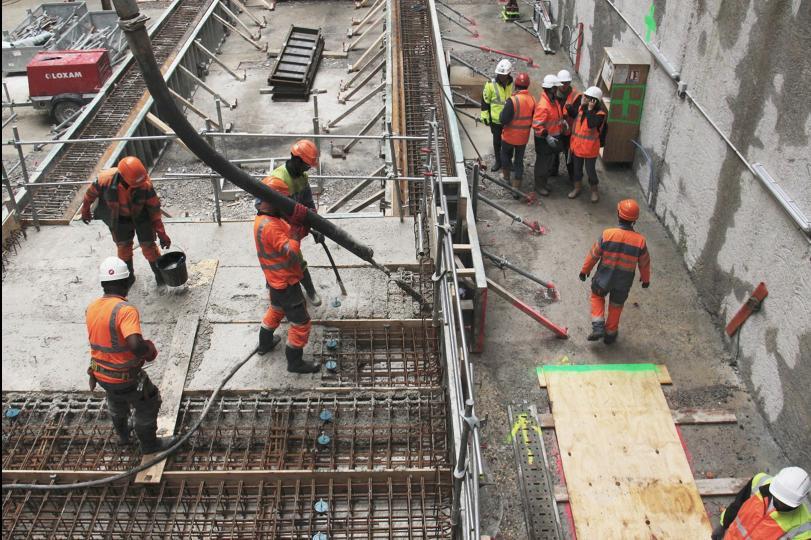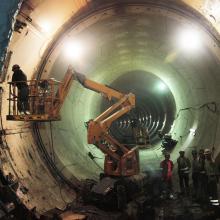The COSEA project
The aim of the COSEA (co-activity and safety in action) human sciences research project is to closely analyze real-life work site scenarios, where teams from different core businesses find themselves working inter-dependently in highly restrictive environments that present certain safety challenges (underground, for example).
Launched by the IRSN in December 2015, the COSEA project is intended to offer ideas for reflection on the risks associated with co-activity and the tools likely to be implemented to prevent them. In conjunction with the Center for the Sociology of Organizations (CSO) at the Paris Institute of Political Studies ("Sciences Po"), the Institute is following and observing the project to extend line 14 of the Paris metro, carried out by French public transport operator RATP, under a three-way partnership agreement. The findings from this research project will feed into the assessment reports that the IRSN produces in relation to co-activity within the Cigéo project (the industrial center for the deep disposal of radioactive waste), or during nuclear facility dismantling operations or major nuclear plant modifications.
The promising results obtained in the first phase of the project (2015-2018) have led the IRSN and its partners to agree on an extension to 2023.
Context and objectives
The aim of the COSEA project is to gain a better understanding of the challenges of co-activity in environments that are complex and restrictive from a safety point of view. This is the case for the Cigéo project (which gave rise to the construction of an underground laboratory in Bure (Meuse/Haute-Marne region) to assess the possibility of developing a waste disposal facility in a deep clay formation), as well as for nuclear facility dismantling operations and major plant modification projects.
The chosen area of investigation was RATP's project to extend line 14 of the Paris metro due to its variety of characteristics, and particularly the frequency of co-activity situations, with civil engineering and road planning teams working alongside operations and works teams in highly restrictive environments.
The adopted method is essentially ethnographic and combines two distinct sociological approaches: the sociology of risks, which examines the social and individual perceptions of risk, and the sociology of work, which focuses on human and organizational dynamics in association with modes of governance and management styles and techniques. Various people employed at the work site are interviewed on a voluntary basis, including production managers, maintenance managers, works supervisors, site foremen, tunnel boring machine operators and team members. At the same time, a certain number of operations are observed and photographs taken to provide a visual record of the progress made.
The method takes account of:
- the design and organization of these work situations,
- the modes of cooperation between co-workers from the same company and from different companies, and interactions between the different hierarchical levels,
- the characteristics of the underground environment (confined space, ventilation and accessibility constraints, etc.),
- the "work site" configuration in which activities are distributed and dispersed across time and space.
Phase 1
The first phase of the COSEA project highlighted the fact that the work site area combines two characteristics: it is both the work space and the work material. The given framework (available areas at surface level and underground) and its consistency (ground that may be more or less movable and easy to work) influence the ways in which productive activity can take place. In return, the work carried out in the space (excavation, concrete casting, etc.) modifies the space, which, in turn, organizes and changes the framework. It is within this constant dialectical state, between action and its framework, that the challenges of co-activity and the conditions of safety management lie. The work site is subject to conflicting definitions of the spaces, which characterize and explain the complexity of the co-activity situations.

This first phase also provided an opportunity to analyze co-activity through the challenges that different work spaces present. First and foremost, there is the need to preserve one's own work space despite the co-activity situation. However, sometimes it is important to accept that the boundaries of a work space need to be adapted and adjusted (negotiated space) to allow the project as a whole to progress, while continuing to adhere to the established financial principles (contractual space). A fine balance needs to be found, which will often require negotiation and decision-making with a third party.
However, the complexity of co-activity situations does not only lie in the technical process of the construction project. The staff facilities at the work site, which are sometimes neglected and considered as being of only secondary importance, actually help organize and support co-activity. Finally, co-activity situations do not only stem from the physical proximity of work teams. The environment, the storage areas and the circulation of flows are also part of the work space and will indirectly define and redefine co-activity situations.
The findings have been published in an initial summary report.
Phase 2
The aim of the second phase of the project, which will continue until 2023, is to extend and carry out a more detailed examination of the approach to co-activity in terms of spaces, in order to analyze the interlocking elements of co-activity in an increasingly tense context as the official deadline for the opening of the extension draws closer. Co-activity situations are becoming widespread, with less and less room (both literally and figuratively) for negotiation. They are also transforming, as tasks begin to be carried out remotely, by means of interfaces between humans and machines.

By the end of this second research phase, the entire life of the project will have been mapped out, from beginning to end. It will then be possible to release findings on the link between safety/security and co-activity.
The results will be put into perspective with the Cigéo project as well as with nuclear facility dismantling operations or major nuclear plant modification projects. This will provide answers to questions asked in the assessment report about co-activity situations in the light of safety challenges.
Expected results and aims
The COSEA project is expected to allow the Institute to build an assessment model of the risks associated with co-activity. The results should be useful for assessing all types of situations with safety challenges, involving a large number of "heterogeneous" players who are likely to be pursuing different goals and interests. This model should address the following questions in particular:
- What risks associated with the "work site" area are likely to have an impact on the safety of the operating area, and what are the procedures for "disseminating" any information on these risks to the operating area?
- What requirements can be formulated with regard to the components used for separating the work site and operating areas and for preventing the risks associated with co-activity?
- What organizational measures need to be implemented to maintain the principle of a "closed and independent" work site?
